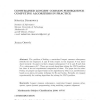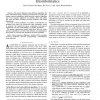697 search results - page 39 / 140 » Improving EAs for Sequencing Problems |
BMCBI
2005
13 years 9 months ago
2005
Background: Alignments of homologous DNA sequences are crucial for comparative genomics and phylogenetic analysis. However, multiple alignment represents a computationally difficu...
CAI
2010
Springer
13 years 6 months ago
2010
Springer
The problem of finding a constrained longest common subsequence (CLCS) for the sequences A and B with respect to the sequence P was introduced recently. Its goal is to find a longe...
BMCBI
2008
13 years 9 months ago
2008
Background: Nonnegative matrix factorization (NMF) is a feature extraction method that has the property of intuitive part-based representation of the original features. This uniqu...
TCBB
2010
13 years 7 months ago
2010
— We present efficient cache-oblivious algorithms for some well-studied string problems in bioinformatics including the longest common subsequence, global pairwise sequence alig...
BMCBI
2006
13 years 9 months ago
2006
Background: Although it is not difficult for state-of-the-art gene finders to identify coding regions in prokaryotic genomes, exact prediction of the corresponding translation ini...


